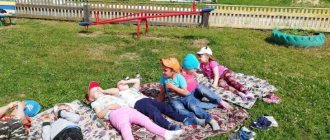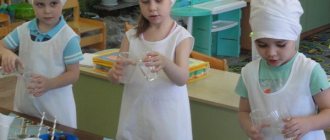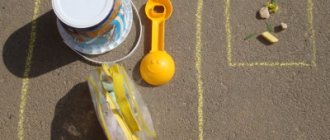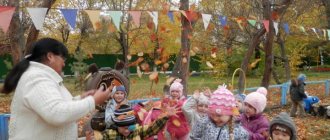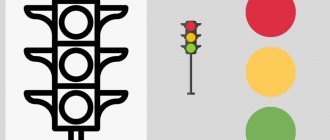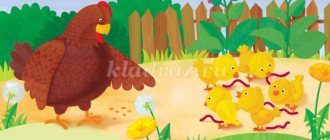Card index of walks in the summer (first junior group)
Polina Divgun
Card index of walks in the summer (first junior group)
Card index of walks in the 1st junior group “Summer”
CARD 1 . Bird watching.
Goal: to consolidate the structural features of what they do: fly, sit on trees, chirp merrily, peck. “Pigeons, pigeons - one, two, three. The shizori pigeons have arrived. They sat down and ruffled their faces at the door. Who will feed the Sisars with crumbs?”
D/i: “How do birds sing?” Goal: development of auditory perception and articulation.
Game exercise: “Who’s next?” Goal: to teach standing long jump.
Labor assignment. Show how to rake sand into a pile with shovels and transfer it in buckets to the sandbox. Goal: to instill in children basic work skills.
P/n: “Sunshine and rain.” Goal: to teach children to walk and run in all directions, without bumping into each other, to teach them to act on the teacher’s signal.
Independent play activity.
Goal: to teach children to play together and share toys; push strollers and play with balls carefully, without bumping into each other.
CARD 2 . Monitoring the weather conditions.
Purpose: to clarify with the children the weather conditions: a fine day, hot, warm, a warm breeze is blowing. “The sun looks out the window, looks into our room, we clap our hands - we are very happy about the sun.”
Role-playing game “On a walk in the park. ” Goal: to promote children’s desire to independently select toys and attributes for play, to use substitute items.
D/i: “Find and name. Goal: to develop the ability, according to the teacher’s verbal instructions, to find objects and name them, their color, size, shape.
P/n: “Through the stream.” Goal: to strengthen children’s ability to walk on an inclined board while maintaining balance.
Labor activity: drawing in the sand with a finger. “Sun”. Goal: to develop children’s imagination, strengthen the ability to draw rounded shapes.
Independent motor activity.
Target. To instill in children a desire to perform physical exercises. exercises
CARD 3 . Tree watching.
Goal: to teach children to see the differences and similarities between coniferous and deciduous trees.
Riddle “Stands on white legs, earrings on branches”
.
P/n: “One, two, three – run to the birch tree.” Goal: distinguish between trees, act on a signal.
Labor assignment - washing toys after a walk . Purpose: to instill in children basic labor skills.
P/n: “Birds in nests.” Goal: to teach children to walk and run in all directions without bumping into each other, to teach them to act on the teacher’s signal.
D/i: “Find the same leaf.” Purpose: to learn to differentiate leaves by size and shape.
Games with water and sand. Purpose: to expand children’s knowledge about the properties of sand / dry pours, wet can be sculpted.
CARD 4 . Insect observation.
Goal: learn to name: butterfly, beetle, ladybug, behave calmly near insects without harming them.
Riddle “Zhu, zhu, zhu.” I'm sitting on a branch, the letter "w"
I tell everyone."
D/i: “How a beetle buzzes.” Goal: to develop auditory perception, develop the articulatory apparatus.
Game exercise: “Jump over the cord.”
Goal: practice jumping over obstacles.
Labor assignment: rake sand into a pile and transfer it to the sandbox. Purpose: to introduce children to performing simple labor actions.
P/n: “Sunshine and rain.” Goal: to teach children to walk and run in all directions, without bumping into each other, to teach them to act on the teacher’s signal. S/r game: “Let's teach Katya to use a handkerchief.” Goal: to develop skills in using ind. objects.
CARD 5 . Watching cars on the street.
Goal: to reinforce with children the rules of behavior on the road / you can move along the street and cross it only with an adult, holding hands tightly.
D/i: “Wonderful bag” /cones, pebbles, sticks/. Purpose: to teach children to differentiate the shape of an object and introduce the concept of weight.
Labor assignment: water the flowers in the flower garden. Goal: teach children to help adults, care for the plants in the flower garden.
P/n: “Birds in nests.” Goal: to teach children to walk and run in all directions without bumping into each other, to teach them to act quickly on the teacher’s signal, to help each other.
Playing with water and sand: “I bake, bake, bake...” Goal: to teach how to properly fill a mold with sand, turn it over, and decorate the finished Easter cake.
P/n: “Carousel. Goal: to teach children to run after each other at different paces, to perform actions in accordance with the text of the game.
Independent play activity.
Goal: teach children to play together and share toys.
CARD 6 . Dandelion observation.
Goal: recognize a dandelion by appearance, name it; determine the color of its flower; develop a sense of beauty. “A dandelion wears a yellow sundress, and when it grows up, it will dress up in a little white dress.”
P/n: “BUBBLE”. Goal: to teach children to stand in a circle, to make it wider, tighter, to teach them to coordinate their actions with the spoken words.
Labor assignment: collect toys in a basket at the end of the walk . Purpose: to accustom children to carry out simple labor assignments.
D/i: “Find the same flower.” Purpose: to teach children to find an object according to the model.
Playing with water: “Drowning and swimming.” Purpose: to expand children’s understanding of the properties of water /some drown, others swim/.
Independent motor activity. Purpose: to support games in which movements are improved (walking, running, throwing, rolling).
CARD 7 . Observing plants blooming in a flower bed.
Goal: teach to admire plants, but not tear them. Reinforce the names of plant parts: stem, flower.
D/i: “Moms and babies.” Purpose: to consolidate knowledge about poultry and their young.
Work assignment on site: watering seedlings.
Target. Help adults take care of plants.
P/n: “Airplanes.” Goal: to teach children to run in different directions without bumping into each other, to act on a signal.
Telling the poem by Z. Alexandrova: “Dandelion.” Purpose: to consider the dandelion. Introduce children to the beauty of the world around them.
S/r game: “Family”. Target. Teach children to play together and take on certain roles.
Independent play activity. Goal: to teach children to play together in small groups .
CARD 8 . Watching the wind.
Goal: watch the trees sway, listen to the rustling of the leaves. “I saw how the breeze flew towards us towards the light. He creaked the window frame and quietly pushed the window open.”
Didactic exercise: “How the wind makes noise.” Goal: development of auditory perception and development of articulation.
P/n: “My cheerful, ringing ball...” Purpose: to teach children to jump on two legs, listen carefully to the text and catch up with the ball only when the last words are spoken.
Job assignment: “Washing toys.” Purpose: to teach children to perform simple pond activities.
Drawing on the sand with a stick: “Grass - ant” Goal: continue to teach children to draw grass with short and long straight lines.
Independent play activity. Goal: to teach children to play together in small groups .
CARD 9 . Watching the rain.
Purpose: to tell that summer rain can be different / warm, with thunder and lightning /, after the rain puddles appear, trees, asphalt, and the ground are wet. “It’s raining, it’s raining, it’s pouring, it’s going to get our kids wet.”
.
Sedentary game: “Sunshine and Rain.” Goal: to get an emotional charge and cause physical activity. .
Labor assignment. Watering flowers in a flower garden.
Goal: to cultivate hard work and a desire to care for plants.
Game exercise: “On a narrow path.” Purpose: to learn to step from circle to circle /drawn with chalk on the asphalt/.
D/i: “Who is the odd one out.” Target. learn to classify objects, highlighting the extra ones.
Independent play activity. Goal: to teach children to play in small groups , to play together, without quarreling, to share toys.
Card 10 . Monitoring the work of the janitor.
Goal: to emphasize the importance of work for everyone. Foster respect for working people. /What does the janitor do? Why do you need the profession of a janitor? What tools does he use in his work? “The janitor gets up at dawn and cleans the porch in the yard. The janitor removes the trash and sweeps the paths.”
P/n: “Sparrows and the cat.” Goal: to learn to run without touching each other, to quickly run away, to find your place.
Labor assignment. Cleaning up toys before leaving for a walk . Purpose: to accustom children to perform simple labor actions.
Sedentary game: “Get into the basket.” Develop the ability to throw objects in a certain direction with both hands, develop eye and dexterity.
D/i: “What’s for what.” Purpose: to form an idea of the significance of each human organ: eyes - look, etc. d.
Independent play activity. Purpose: To teach children to group in two or three people for joint games.
CARD 11 . Traffic light.
Goal: to consolidate children’s ideas about the meaning of a traffic light.
Game task: How many colors does the traffic light have?
“When I found myself in a big and noisy city, I was confused, I was lost... Not knowing the traffic lights, I almost got hit by a car.” Give the children red and green circles; the teacher has a yellow circle. Clarify what these colors mean, then pay attention to how the traffic light works. Children show circles that correspond to a traffic light signal. The teacher once again talks about the purpose of flowers.
Labor activity - we will put away the toys after a walk . Goal: to perform the simplest labor actions.
D/i “What color do we have?” Purpose: to teach children to name items of clothing and their color. Develop attention.
P/n “My funny ringing ball.” Purpose: to teach children to jump on two legs, listen carefully to the text, and catch up with the ball only when the words are spoken.
Games with water: “Dives”. Goal: to consolidate the properties of objects. /Show that small ping pong balls do not sink, but jump out of the water/.
Independent play activity with external material Purpose: to teach children to independently select attributes and substitute toys for games. CARD 12 Observing the sun.
Goal: Compare the summer season with other times, find similar and distinctive features. Give an idea of the weather conditions in summer. Fix the names of seasonal clothing.
Game task: The sun is shining brightly, it has become very warm. Summer is also different in that many flowers bloom. Everything around is green.
The sun is shining brightly,
There's warmth in the air
And wherever you look,
Everything around is light.
I. Surikov
Outdoor games
"At the Bear's Forest"
- learn to run without bumping into each other.
"Shaggy Dog"
- develop children’s ability to move in accordance with the text, quickly change direction of movement, run, trying not to get caught by the catcher and without pushing
S. R. And “Chauffeurs”
— introducing children to the profession of a driver.
Teach children to establish relationships in play. To develop the ability to interact in stories with two characters (driver-passenger)
. Encourage children to try to independently select attributes for a particular role.
CARD 13 Observing the sky and clouds.
Goal: to understand the concept of “cloud”
, the dependence of weather on the presence of clouds.
Main content: On a cloudy day, ask the children what they see in the sky. Notice that the clouds are moving, sometimes moving slowly, sometimes quickly. What are they? If there are clouds in the sky, they cover the sun, then it is not so hot outside.
Clouds,
White-maned horses
Clouds,
Why are you rushing without looking back? S. Kozlov
Outdoor games
1."Catch a mosquito"
— To develop in children the ability to coordinate movements with a visual signal, to train children in jumping
(bouncing on the spot)
.
2."Sparrows and the cat"
— To develop in children the ability to fit in space and move in a group without touching each other. Act on a signal, practice deep jumps, standing long jumps, and fast running.
S.R. And “At the Doctor’s”
— Familiarize children with the activities of a doctor, reinforce the names of medical instruments.
Teaching children to implement game plans. To develop the ability to interact in stories with two characters (doctor - patient)
; to individual in games with substitute toys, play the role for yourself and for the toy.
Independent play activities of children with external materials.
CARD 14 Observation of the properties of sand and soil.
Goal: Identify the properties of sand and soil, determine their similarities and differences.
Main content: Compare the color of dry and wet sand. You can sculpt figures from wet sand, but dry sand crumbles very quickly and does not hold its shape. Invite children to build sand figures and determine for themselves the difference between dry and wet sand.
Don't let your parents get angry
That the builders will get dirty,
Because the one who builds
He's worth something! B. Zakhoder
Outdoor games
1. "Run to the flag"
.Goal: to teach to perform actions strictly according to the teacher’s signal. Development of children's attention and ability to distinguish colors. Running and walking exercise.
2. "The Mother Hen and the Chicks"
— To develop in children the ability to perform movements on a signal, to practice running in different directions and crawling.
S.R. And “Treat”
— developing children’s ability to implement game plans. Encourage children to try to independently select attributes for a particular role; supplement the play environment with missing items and toys.
Independent play activities of children with external materials.
Progress of observation.
When going out for a walk , the teacher notices how clean the area is. Why is it so clean around here? Talk with children about the work of a janitor in the spring season, about the need for this work for people. Why is he doing this? What tools does a janitor have? (The janitor works with a large broom, a shovel, he has a bucket, and he also has a large watering can.)
The janitor will get up at dawn,
Everything will be cleaned in the yard
And he will trim the bushes himself,
Beauty is our joy!
The janitor takes a watering can and begins to water the flower beds. What does the janitor water the flowers with? Why is he doing this? (So that the flowers grow.)
The children and the janitor move along the flowerbed.
How does water flow from a watering can? (Slowly.)
What flowers does the janitor water? Flowers wash themselves, drink water, raise their heads to the sun, and smile at everyone. What should you do to thank the janitor for his work? Encourage children to want to be clean.
D/game “Who needs what for work?”
Target. To consolidate children's knowledge that different things help people in their work - tools, to cultivate an interest in the work of adults, a desire to work.
P/games “Twisting Path”
.
Target. Learn to move in a column behind the leader, repeating his movements .
"Swing"
. Target. Learn to perform various rhythmic movements; development of coordination and balance.
Work. Collect pebbles near the trees. Target. Instill respect for nature. Provide all possible assistance to adults.
Individual work. "Nimble Bunnies"
. Target. Learn to jump on two legs while moving forward.
Independent play activities of children with external materials
Target. Develop the ability to perform game actions in game exercises, play on topics from the surrounding life. Introduce basic generally accepted norms and rules of relationships with peers and adults. Stimulate the development of interest in joint games with adults and children, a positive response to the offer to play.
Card No. 3
Subject. "Hello, weed!"
Target. Continue monitoring the spring grass. Develop observation skills. Activate children's vocabulary. Foster a love of plants.
Progress of observation.
The snow has melted and young grass is growing on the ground. Look how beautiful it has become around. Carefully touch the delicate green blades of grass, stroke them, saying: “Green grass, flutter, show yourself to the golden sun.”
. What kind of grass? Small, soft, fluffy. Explain to the children that the first, young, green grass must be protected, it cannot be torn and trampled.
Breaks through to the sun
Green grass.
Ah, spring is beautiful,
You are right as always!
D/game “Knock-knock”
. Target. Exercise children in pronouncing sounds at different volumes. Form correct and clear pronunciation of sounds.
P/games “Sparrows and the car”
. Target. Learn to act quickly on a signal; run without bumping into each other. Cultivate a caring attitude towards peers.
“The gray bunny washes himself”
. Target. Learn to listen to the text and perform movements in accordance with the content.
Work. Collect dry twigs and stones from the area. Target. It’s hard work to cultivate desire.
Individual work. “Knock down the pins”
(3-5 pins)
. Target. Develop your eye.
Independent play activities of children with external materials.
Target. Develop the ability to perform game actions in game exercises, play on topics from the surrounding life. Introduce basic generally accepted norms and rules of relationships with peers and adults. Stimulate the development of interest in joint games with adults and children, a positive response to the offer to play.
Card No. 4
Subject. "Brighter, shine the sun"
.
Target. Continue to acquaint children with the phenomena of inanimate nature, the changes occurring with the sun. Maintain a good mood while walking .
Progress of observation.
Pay attention to the paths. It rained and left puddles on the paths. What are they like? To small lakes. What's that there in the puddle? This displays the sky and clouds. And if we look into the puddle, we will see ourselves there. Each puddle is like a small mirror.
This puddle is like a ring
This puddle is a heart,
This puddle is like a banana
This one is like an ocean.
But in this long puddle
Suddenly I discovered myself.
D/game “Frog and little frogs”
. Target. Develop speech attention and voice power in children.
P/games “Inflate, my ball”
.
Target. Teach children to perform various movements, forming a circle. Practice pronouncing the sound “Ш”
.
“Who will run along the path faster?”
. Target. Achieve good jumping technique when taking off.
Work. Putting things in order, collecting branches. Target. Promote the desire to work together and experience the joy of communicating with each other.
Individual work. Improving beam walking technique. Target. Strengthen balance skills by walking on a log.
Independent play activities of children with external materials.
Target. Develop the ability to perform game actions in game exercises, play on topics from the surrounding life. Introduce basic generally accepted norms and rules of relationships with peers and adults. Stimulate the development of interest in joint games with adults and children, a positive response to the offer to play.
Card No. 7
Subject. Observation "Sunny Bunny"
Target. clarify children's ideas about sunlight. cultivate interest in natural phenomena.
Progress of observation.
A crow is a bird. It is large, black-gray, most often flies alone, builds a nest high in a tree. Doesn't come to the feeder. The crow caws loudly.
“The black bird is spinning, Kar-kar-kar,” it screams and gets angry
A well-known person, and her name is crow.”
D/game “What does it sound like?”
Target. Develop auditory perception. Teach children to distinguish onomatopoeic words by ear and differentiate them by volume. Show independence and initiative.
P/games “Migration of birds”
. Target. Practice climbing. Develop coordination of movements.
"Who left?"
. Target. Develop attention and spatial orientation. Cultivate sympathy for each other.
Work. Let's put the toys in our bags. Target. Teach children to clean up the area after a walk .
Individual work “Who will throw the bag further?”
Target. Practice throwing and develop arm strength. Cultivate a desire to do physical exercise.
Independent play activities of children with external materials.
Target. Develop the ability to perform game actions in game exercises, play on topics from the surrounding life. Introduce basic generally accepted norms and rules of relationships with peers and adults. Stimulate the development of interest in joint games with adults and children, a positive response to the offer to play.
Card No. 12
Subject. "Sun, shine merrily..."
Target. Continue to introduce children to the phenomena of living and inanimate nature in the spring. Learn to establish cause-and-effect relationships between phenomena. Help broaden your horizons.
Progress of observation.
The teacher says that there are different types of rain: heavy, infrequent, summer, autumn, spring. Explains the difference to children. You can use two watering cans: a children's watering can and a large garden watering can. The teacher clearly shows the difference between heavy rain and light rain. You can pour warm water into one watering can and cold water into the other. Let children touch the base of the watering can. Conclusion: cold spring rains are dangerous to health. You need to walk under an umbrella.
Rain, rain, what are you pouring down, you don’t let us take a walk!
I am rainwater, my land, mine, mine
I wash the beds and the fence, I remove rubbish from the paths,
And I wash the gates, and the trees, and the bushes
So that tomorrow morning everyone will be smart and clean.
D/game "Steam Locomotive"
. Target. Develop sound culture of speech.
P/games "Vesnyanka"
. Target. Coordination of speech with movement, development of general speech skills.
"Stream"
. Target. Strengthen the ability to move in one direction and not bump into each other.
Work. Letting streams flow. Develop the ability to work, show independence, and initiative.
Individual work. Stepping over cords, cubes, bars in a straight direction. Target. Develop coordination of movements and balance.
Independent play activities of children with external materials.
Target. Develop the ability to perform game actions in game exercises, play on topics from the surrounding life. Introduce basic generally accepted norms and rules of relationships with peers and adults. Stimulate the development of interest in joint games with adults and children, a positive response to the offer to play.
Card No. 6
Subject. "Watching the Puddles"
.
Target. Expand children's understanding of natural phenomena and their significance in our lives. Develop speech and thinking.
Progress of observation.
The teacher pays attention to the insects that can be found on the site. Clarify that butterflies and ladybugs, flies fly, ants crawl on the ground. You cannot catch insects for fun: it makes them feel bad. Little creatures want to eat, they need to work, feed their babies. Show how beautiful butterflies are in the sun, how bright and shiny their wings are!
Guys, I’m a butterfly... Come closer slowly.
My house is not a jar. Admire and look!
Put away your net and the hunt will appear -
And close it with a hook. You can even take a photo.
D/game “Who is doing what?”
Target. Fix the name of the insects. Learn to master the prefix method of forming verbs.
P/games "Grasshoppers"
. Target. Learn to perform actions according to words. Develop coordination of movements.
"Migration of Birds"
. Target. Exercise children in climbing stairs, jumping, running; learn to move from one action to another; develop dexterity and the ability to navigate in space.
Work. Let's collect twigs and sticks. Target. Teach children to help adults. Cultivate hard work.
Individual work. "Walk on the bridge"
. Target. Practice walking and running between objects. jumping from a bench onto bent legs.
Independent play activities of children with external materials.
Target. Develop the ability to perform game actions in game exercises, play on topics from the surrounding life. Introduce basic generally accepted norms and rules of relationships with peers and adults. Stimulate the development of interest in joint games with adults and children, a positive response to the offer to play.
Card number 10
Subject. "Trees in Spring"
.
Target. Expand children's knowledge about the names of trees and their structure. Note seasonal changes. Learn to find cause-and-effect relationships. Foster a love for the nature of your native land.
Progress of observation.
Observe the poplar. Young poplar leaves are covered with sticky (sticky)
fragrant substance. Invite children to rub it between their fingers and smell it. The light green color of the trees is tender and transparent at this time.
On the trees -
Look, -
Where the buds were
Like green lights
The leaves flashed.
D/game “One and Many”
. Target. Fix the name of the trees. Learn to coordinate in numbers.
P/games “Hares and wolves”
.
Target. Teach children to listen carefully to the teacher, perform jumps and other actions in accordance with the text. Learn to navigate in space, find your place (bush, tree)
.
"Run to me"
. Target. Develop mobility, the ability to move in a team, run quickly and respond to signals.
Work. Putting things in order, collecting branches. Target. Promote the desire to work together and experience the joy of communicating with each other.
Individual work. Improving beam walking technique. Target. Strengthen balance skills by walking on a log.
Independent play activities of children with external materials.
Target. Develop the ability to perform game actions in game exercises, play on topics from the surrounding life. Introduce basic generally accepted norms and rules of relationships with peers and adults. Stimulate the development of interest in joint games with adults and children, a positive response to the offer to play.
Card No. 9
Subject. "Insects on the site"
.
Target. Learn to recognize insects by their distinctive features. Expand children's knowledge about the life of insects. Foster a caring attitude towards the natural world.
